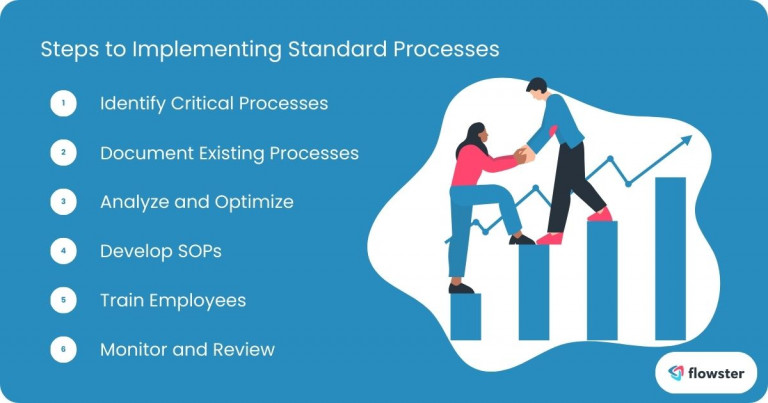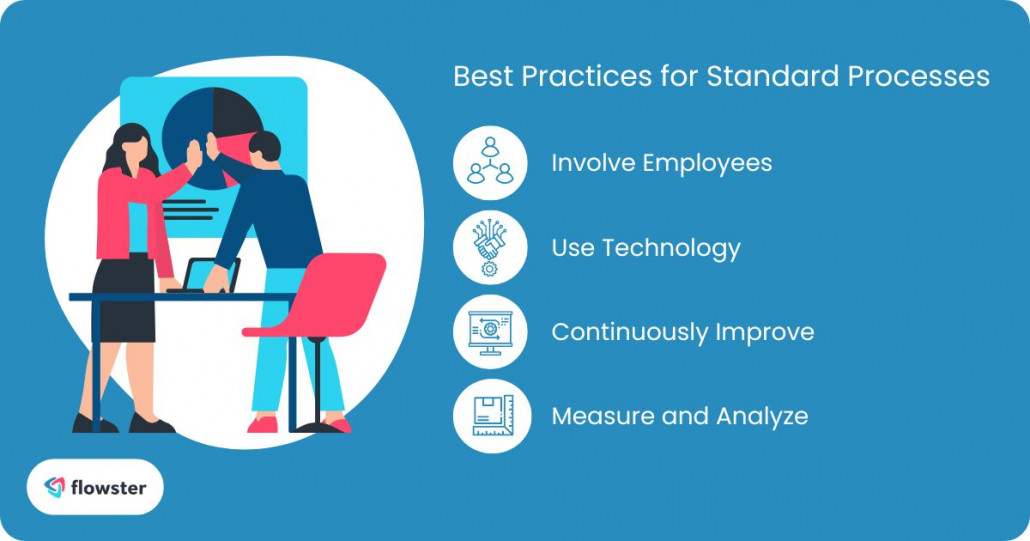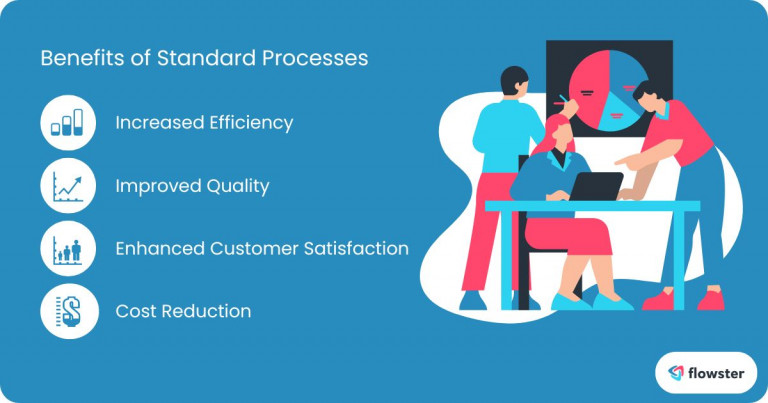In today’s competitive business landscape, small to medium-sized enterprises (SMEs) face immense pressure to operate efficiently and deliver exceptional results. One critical factor that can significantly impact a business’s success is the implementation of standard processes. By establishing clear, consistent procedures, SMEs can streamline their operations, enhance quality, and improve customer satisfaction.
This guide aims to provide a comprehensive overview of standard processes, their benefits, and practical strategies for implementation. We will explore how process standardization can contribute to business efficiency, quality control, cost reduction, and overall organizational success. By the end of this guide, you will have a solid understanding of how to harness the power of standard processes to drive your SME forward.
Article Outline
What are Standard Processes?
Standard processes are well-defined, repeatable sequences of activities that guide how tasks are performed within an organization. These processes ensure consistency, efficiency, and quality throughout various operations. By establishing clear guidelines, businesses can avoid errors, reduce waste, and improve overall performance.
Why are Standard Processes Important?
- Consistency: Standard processes ensure that tasks are performed consistently, reducing errors and inconsistencies in output.
- Efficiency: By streamlining workflows, standard processes can eliminate unnecessary steps, improve efficiency, and save time.
- Quality: Consistent processes lead to more predictable outcomes, improving the overall quality of products or services.
- Compliance: Standard processes can help businesses comply with industry regulations and standards.
- Scalability: Well-defined processes make it easier for businesses to grow and scale operations.
Examples of Standard Processes:
- Manufacturing: Production lines, quality control procedures, and inventory management processes.
- Customer service: Complaint handling procedures, sales processes, and technical support procedures.
- Human resources: Hiring processes, performance evaluation procedures, and training programs.
- Finance: Accounting procedures, budgeting processes, and financial reporting processes.
As we can see, standard processes are essential for businesses of all sizes. By implementing effective standard processes, organizations can improve their operations, enhance customer satisfaction, and achieve long-term success. Let’s delve deeper into the specific benefits that standard processes can offer.
Benefits of Standard Processes
Standard processes offer numerous advantages for businesses of all sizes. By implementing well-defined procedures, organizations can improve efficiency, quality, customer satisfaction, and ultimately, their bottom line.
Increased Efficiency
- Streamlined operations: Standard processes eliminate unnecessary steps and reduce bottlenecks, leading to smoother workflows and faster turnaround times.
- Reduced waste: Consistent procedures help minimize waste, such as materials, time, and resources, resulting in significant cost savings.
- Improved productivity: When employees follow clear guidelines, they can focus on their tasks more effectively, leading to increased productivity.
Improved Quality
- Consistency: Standard processes ensure that tasks are performed consistently, reducing the risk of errors and defects.
- Higher standards: By setting clear expectations, standard processes can help organizations achieve and maintain higher quality standards.
- Customer satisfaction: Consistent quality leads to satisfied customers and repeat business.
Enhanced Customer Satisfaction
- Predictability: Standard processes provide customers with a predictable experience, leading to increased satisfaction and loyalty.
- Faster response times: Well-defined procedures can help businesses respond to customer inquiries and requests more quickly.
- Improved service quality: Consistent processes ensure that customers receive consistent and high-quality service.
Cost Reduction
- Reduced waste: As mentioned earlier, standard processes can help minimize waste, leading to significant cost savings.
- Improved efficiency: By streamlining operations, standard processes can reduce the need for additional resources, resulting in lower operating costs.
- Error reduction: Consistent procedures can help reduce errors, which can be costly to correct.
As you can see, the benefits of standard processes are substantial. By implementing well-defined procedures, businesses can improve their operations, enhance customer satisfaction, and achieve long-term success. Let’s explore how to effectively implement standard processes in your organization.

Implementing Standard Processes: A Step-by-Step Guide
Implementing standard processes can be a daunting task, but with a well-planned approach, it can be a rewarding endeavor. Here’s a step-by-step guide to help you successfully implement standard processes in your organization.
Step 1: Identify Critical Processes
- Importance: Identifying the most critical processes in your business is essential for focusing your efforts on areas that will have the greatest impact.
- Methods: Use techniques like process mapping, interviews, and observations to identify key processes.
- Prioritization: Prioritize processes based on factors such as frequency, complexity, and impact on business goals.
Step 2: Document Existing Processes
- Importance: Documentation provides a clear understanding of current procedures and serves as a baseline for improvement.
- Methods: Use process mapping tools, flowcharts, or written descriptions to document existing processes.
- Involve employees: Encourage employees to contribute their knowledge and insights to the documentation process.
Step 3: Analyze and Optimize
- Importance: Analyzing existing processes helps identify inefficiencies, bottlenecks, and opportunities for improvement.
- Methods: Use techniques like time studies, value stream mapping, and root cause analysis to identify areas for optimization.
- Involve employees: Employees often have valuable insights into process improvements.
Step 4: Develop Standard Operating Procedures (SOPs)
- Importance: SOPs provide clear and concise instructions for how tasks should be performed.
- Content: SOPs should include clear steps, decision points, and responsibilities.
- Accessibility: Ensure that SOPs are easily accessible to all relevant employees.
Step 5: Train Employees
- Importance: Effective training ensures that employees understand and can follow the new standard processes.
- Methods: Provide comprehensive training programs that cover the content of the SOPs and address any questions or concerns.
- Ongoing training: Consider providing ongoing training to reinforce the standard processes and address any changes.
Step 6: Monitor and Review
- Importance: Ongoing monitoring and review are essential to ensure compliance with standard processes and identify areas for improvement.
- Methods: Use metrics and data to track performance against process standards.
- Continuous improvement: Use the data collected to identify opportunities for further optimization and improvement.
By following these steps, you can effectively implement standard processes in your organization and reap the benefits of improved efficiency, quality, and customer satisfaction. Let’s now explore some best practices for successful process standardization.

Best Practices for Standard Processes
Successful process standardization requires a strategic approach and a commitment to continuous improvement. Here are some best practices to consider:
Involve Employees
- Employee expertise: Employees often have valuable insights into processes and can provide valuable feedback.
- Ownership: When employees are involved in the process standardization process, they are more likely to feel a sense of ownership and commitment.
- Buy-in: Employee involvement can help build buy-in and support for the new standard processes.
Use Technology
- Process mapping tools: These tools can help visualize processes, identify inefficiencies, and streamline workflows.
- Automation: Automation can help reduce manual tasks, improve efficiency, and reduce errors.
- Data analytics: Data analytics can be used to track process performance and identify areas for improvement.
Continuously Improve
- Dynamic environment: Businesses operate in a dynamic environment, and processes may need to be adjusted to adapt to changes.
- Review and update: Regularly review and update standard processes to ensure they remain relevant and effective.
- Learning from failures: Analyze failures and use the lessons learned to improve processes.
Measure and Analyze
- Key performance indicators (KPIs): Establish KPIs to measure the effectiveness of standard processes.
- Data collection: Collect data to track performance and identify trends.
- Analysis: Analyze the data to identify areas for improvement and make data-driven decisions.
By following these best practices, you can effectively implement and maintain standard processes in your organization. Remember, process standardization is a journey, not a destination. By continuously improving and adapting your processes, you can drive efficiency, quality, and customer satisfaction.
Flowster's AI-Driven Automation
The Power of Standard Processes: A Final Thought
Standard processes are a powerful tool for businesses of all sizes. By implementing well-defined procedures, organizations can improve efficiency, quality, customer satisfaction, and ultimately, their bottom line.
Key benefits of standard processes include:
- Increased efficiency
- Improved quality
- Enhanced customer satisfaction
- Cost reduction
To successfully implement standard processes, consider the following best practices:
- Involve employees
- Use technology
- Continuously improve
- Measure and analyze
Are you ready to unlock the potential of standard processes in your business? Start by identifying your most critical processes and documenting them. Then, analyze and optimize these processes to identify opportunities for improvement. Develop clear standard operating procedures (SOPs) and train your employees on the new procedures. Finally, monitor and review your processes to ensure ongoing compliance and identify areas for further improvement.
Need some help getting started? Flowster Marketplace offers free standard processes templates and other SOP templates to help you streamline your operations. If you’re looking for a more comprehensive solution, consider our “Done-for-You” services. Our experts can help you develop, implement, and optimize standard processes tailored to your specific needs.
Don’t wait any longer. Take the first step towards improving your business operations by implementing standard processes today.





